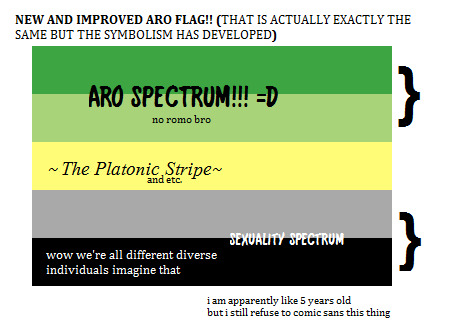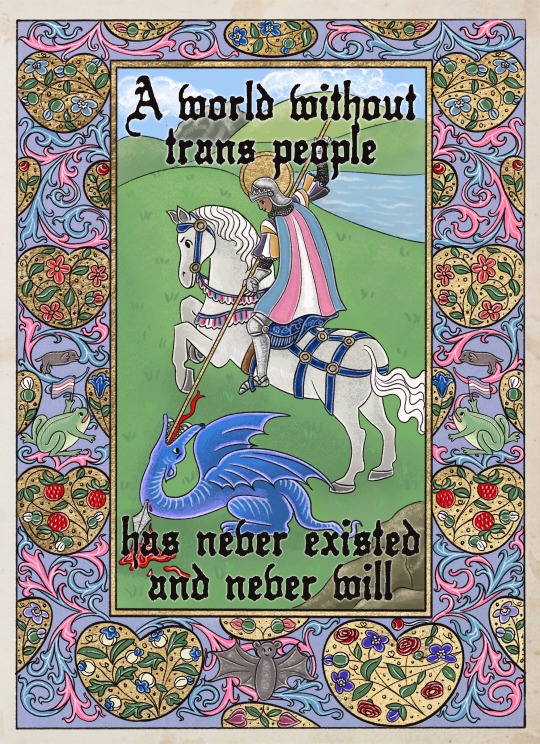Don't wanna be here? Send us removal request.
Photo

over the past few months i’ve been reviewing my design of the aro flag, and stuff that’s occurring in the community and i guess kind of regretting (or re-evaluating) some of the design choices i made? not with the colours, mostly just the meanings of the stripes (which were never really set in stone anyway - they kept changing in my mind when people commented their thoughts)
the biggest thing is that because of all the new words and orientations aro-spectrum people are exploring, stripes designated for certain orientations don’t really work in the long run - after all the two top stripes already symbolise the entire community as a spectrum
basically the way i’ve been seeing the flag over the past couple of months has been in three sections - with the top pair of colours and the bottom pair of colours being two spectrums

green-light green - the aro-spectrum (and aromanticism itself represented by green because green belongs to us now hell yeah)
yellow - basically the ‘platonic’ stripe - friendship/platonic and aesthetic attraction/queerplatonic relationships/family, the importance and validity of all non-romantic relationships and feelings and non-romantic forms of love etc. etc. etc. etc.
black-grey - the sexuality spectrum - acknowledging aro-aces, aromantic allosexuals, and everything in between because we are a diverse lot so i think this is better but who knows EVERYBODY MIGHT DISAGREE WITH ME
[the original post]
EDIT: aaaaand here’s my redesign with the white stripe

347 notes
·
View notes
Text
Happy pride month to those who stay closeted out of fear of rejection from friends and family.
Happy pride month to those who have tried to come out but had people flat out deny their queerness and not respect their identity.
3K notes
·
View notes
Text
an absolute fuckton of people at pride rn
80K notes
·
View notes
Text


Growing up I was shaped into a very feminine and fashionable daughter by my parents but there were signs that there was something else going on.
I always knew what looked best on me as a girl, because of my mother and the compliments I received. I knew how to "dress to impress" as it was said too. I constantly asked myself why I wasn't as excited to see myself in these dresses as others were. I figured out over time that I was only happy if others were too, which was a huge red flag that I wasn't dressing for myself. Figuring out what I was feeling was the first step to finding out who I was. In junior year of high school, I got permission to cut my hair super short, and it has essentially stayed short ever since. For the next few years I experienced inner conflicts going against everything I was raised to idolize. The feminine image I had before was slowly chipped away to reveal a more genuinely confident and happy version of myself.
The realization/understanding came to me slowly and steadily as I navigated college as a questioning individual. It was always on my mind but I didn't share this inner conflict often. I preferred to navigate it on my own time and in my own way but it was clear to me that I was on to something and even though I didn't have all the words to explain it I could tell I was going in the right direction because I was becoming more comfortable with myself. I gradually stopped doing the things I "had to do" as a girl like wearing a bra. I was exploring my comfort levels.
What came naturally to me was easier to accept than I expected. The "real me" was less anxious and more self confident and wouldn't ask themselves "what would mom think? What would my parents want?" everytime they were shopping or saw themselves in the mirror. I could tell I was gradually reclaiming myself.
Throughout those years of exploration I also implemented changes like using a different name and using neutral pronouns. People respecting my choices was healing for me.
Figuring out "who we are" can be intimidating but it is more satisfying and freeing than anyone can imagine.
Happy Pride to all.
3 notes
·
View notes
Text

a world without trans people has never existed and never will
prints
76K notes
·
View notes
Text
Trans & Non-Binary People Have Always Been Here - A Brief History
While the modern phrases and terms to describe Transgender individuals feel new to some, we have existed for the entirety of human history. Looking throughout time we find art showcasing a wide variety of bodies in terms of sexual characteristics before the common era, individuals seeking gender affirming care in the first millennium, singular use of the ‘they’ pronoun in writing in 1375, and more examples as human record keeping became more reliable and prevalent.
Below are some historical examples describing the many different ways Trans people have been acknowledged or visible within the Western world and beyond. The designation of the separate worlds is not to imply one over the other but necessary as many incorrectly believe current gender and pronouns to be a result of an American and overall Western ideology.
Due to the prevalence of Colonialism, gender and sex as concepts have become heavily skewed to the European view of “man and woman.” Ironically, this viewpoint negates even those in European nations like Albania who have a history of varied social roles in terms of gender or religions who thrive in the areas such as Judaism. In Judaism, the Talmud has existed since around 200 CE and is a collection of Jewish legal traditions, in it are no less than 7 genders designations. If we take our eyes off the Western view we become aware that hundreds of unique Indigenous societies retain their traditions of third, fourth, fifth, or more genders. These cultures and the variation of gender identities and expressions are not the exception but rather a different kind of rule. One example, the Bugi people of southern Sulawesi recognize five genders, one of which is Bissu, a "transcendent gender" that encompasses all genders or none. To explore further, please see PBS’s interactive map.
Records of persecuted people are smaller or harder to access as history is usually written by a majority or victor. Much of the information we have access to showcases the violence and bias experienced by Trans individuals but it creates a record and shows parts of our history all the same. There is no one way to be Trans now and that most certainly applies to history.
Sources:
Talalay, Lauren E. (2005). "The Gendered Sea: Iconography, Gender, and Mediterranean Prehistory". The Archaeology of Mediterranean Prehistory. Blackwell.
Littlewood, Roland. “Three into Two: The Third Sex in Northern Albania.” Anthropology & Medicine, vol. 9, no. 1, Apr. 2002.
Varner, Eric (2008). "Transcending Gender: Assimilation, Identity, and Roman Imperial Portraits". Memoirs of the American Academy in Rome. Supplementary Volume. 7. Ann Arbor, Michigan: University of Michigan Press
Tess deCarlo, Trans History
Godbout, Louis (2004). "Elagabalus" (PDF). GLBTQ: An Encyclopedia of Gay, Lesbian, Bisexual, Transgender, and Queer Culture. Chicago: glbtq, Inc.
Baron, D. (n.d.). A brief history of singular “they.” Oxford English Dictionary. https://www.oed.com/discover/a-brief-history-of-singular-they
Blakemore, E. (2022, June 24). How historians are documenting the lives of transgender people. National Geographic . https://www.nationalgeographic.com/history/article/how-historians-are-documenting-lives-of-transgender-people
Coming, C. (2016, June 10). Transgender people have always existed. ACLU of Ohio. https://www.acluohio.org/en/news/transgender-people-have-always-existed
Public Broadcasting Service. (2025, March 6). Interactive map: Gender-diverse cultures. PBS. https://www.pbs.org/independentlens/content/two-spirits_map-html/ Scheinerman, R. (2025, March 14). The seven genders in the Talmud. My Jewish Learning. https://www.myjewishlearning.com/article/the-eight-genders-in-the-talmud/
1 note
·
View note
Text
Sunday is the first day of Pride Month, and this pride month is super important. Be as loud and proud as possible. We gotta show them that no matter what they do, we won't go back into hiding
If you can, go to pride or some sort of queer get-together in your town
1K notes
·
View notes
